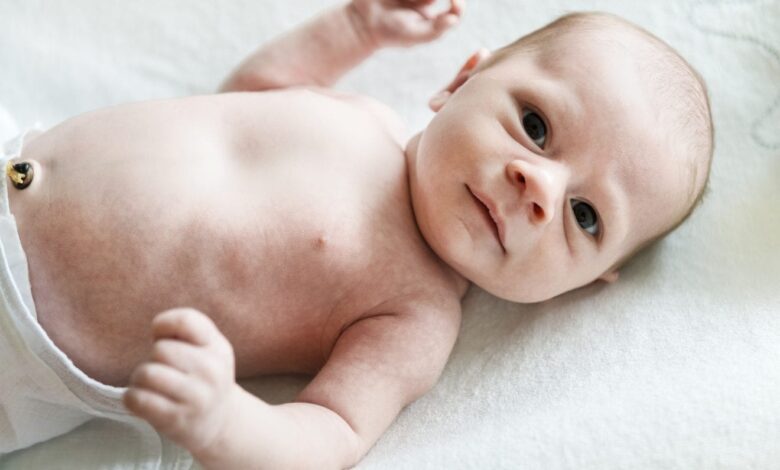How To Care for a Newborn’s Umbilical Cord

As you prepare for your baby’s arrival, you may have started thinking about who will get the honor of cutting your baby’s umbilical cord after birth. But have you ever thought about what happens next? Read more to learn about umbilical cord care, including how to keep it clean, signs of an infected umbilical cord, and things to watch out for after it’s removed.
During pregnancy, your baby’s umbilical cord is vital to their development. Your baby’s umbilical cord supplies the necessary blood, oxygen, and nutrients for growth through its two arteries and one vein. It also removes waste.1 At birth, the function of the umbilical cord is taken over by your baby’s ability to breathe on its own and receive nutrients through feeding. The cord is clamped to stop its blood flow within about 1 inch of your baby’s abdomen.7 The rest of the cord is cut, leaving the umbilical cord stump. Since there are no nerves in the umbilical cord, it is a painless process.1
Care of the umbilical cord can prevent complications such as infection or accidental removal that causes bleeding. After birth, the umbilical cord stump is moist, and if it is not properly cared for and allowed to dry naturally, it can become an ideal place for bacteria to grow and enter your baby’s body.7 An infection of the umbilical cord stump known as omphalitis can spread and become a serious medical emergency.6
Experts no longer recommend cleaning your baby’s umbilical cord with rubbing alcohol. Research studies have shown that it can irritate the surrounding skin and interfere with the natural separation of the umbilical cord stump.2 This is thought to happen because alcohol can remove beneficial bacteria that aid in the elimination process.1
You should check the skin around your baby’s cord stump every day. You may need to gently push down on your baby’s stomach and bend the cord to see the whole area. If you notice any secretions, you can use a wet cotton swab to carefully wipe them and let the skin dry. Only use alcohol to clean the area if instructed to do so by your baby’s provider.6 Although routine cleaning is not necessary, simply washing the stump of the dryer cord gently with plain water and a washcloth and letting it air dry is the best method to use if the cord has become soiled with your pet’s urine or feces. baby1 Umbilical cord stumps need to dry sufficiently before they can be removed naturally.6 You want to sponge bath your baby until the cord comes off.1
When changing their diaper, roll the front down before attaching it to make sure the cord stump isn’t in it. This will help the base of the cord stay dry.2
Detachment of the cord stump is a natural part of your baby’s development. Here are the stages of newborn umbilical cord healing:
- At first, your baby’s cord stump will come in and appear thick and moist with a whitish or blue color.6
- Within a day or two, the cord is dry enough for a healthcare provider to remove the cord clamp. This is usually done before discharge if you gave birth in a hospital.7
- Within days after birth, the cord stump will shrink and turn brown or gray.
- Over time, the color will darken, and the stump of the cord will continue to shrink as it dries.6
- Complete isolation usually takes one to three weeks.1
It may be tempting to remove the dangling cord as it comes off, but it’s important to leave it alone and wait for it to fall out on its own. This will help prevent bleeding of the newborn’s umbilical cord that could result if it is removed too soon.2 If your baby’s cord does not come off on its own after three weeks, notify their health care provider.4
When the time comes, you may be surprised one day to find that your baby’s umbilical cord stump has fallen inside his diaper blanket. Take a good look at their belly button to make sure it is healing properly. If the belly button falls off and appears mushy or yellow underneath, this is a normal and temporary part of healing. A small amount of umbilical cord bleeding is also normal; however, if the bleeding is active, meaning every time a drop of blood is wiped away, another appears, or you see a spot of blood on their onesie that is larger than 2 inches in diameter, this is abnormal. You should contact your baby’s provider right away.4,6
Some babies will develop umbilical granuloma. A small red mass of scar-like tissue remains after the umbilical cord stump is removed.3 Granulomatous tissue produces light yellow or clear mucous drainage without other symptoms of infection. It usually resolves on its own within a week. However, notify your baby’s health care provider if the granuloma persists for more than a week.1 Untreated umbilical granulomas can grow and become a potential site for infection.6 Treatment for umbilical granuloma is usually an application of silver nitrate, which cauterizes or burns the tissue. This area has no nerves, so this process will be painless for your baby.2
Belly button infections (“omphalitis”) are rare, but it is important to distinguish between a normal versus an infected belly button. Signs of infection include a foul-smelling cord, redness, swelling, or tenderness of the skin around your baby’s umbilical cord.1 There may also be yellow drainage or bleeding. Also, your baby may have a fever of 100.4 degrees Fahrenheit or higher, not feel well enough to feed, have poor muscle tone, or feel floppy. Contact their health care provider right away if your baby has any of these symptoms.4
Umbilical cord care requires keeping the cord stump out of the diaper and dry. It is important to check the cord and surrounding skin daily for signs of infection and only give a sponge bath until the cord is completely removed. If you have any concerns about bleeding or drainage after this happens, be sure to talk to your baby’s health care provider.
Newborns come into this world with unique vulnerabilities that require special care and attention. Now that you know how to care for your baby’s umbilical cord stump, enjoy this time with your baby because this stage doesn’t last forever.





